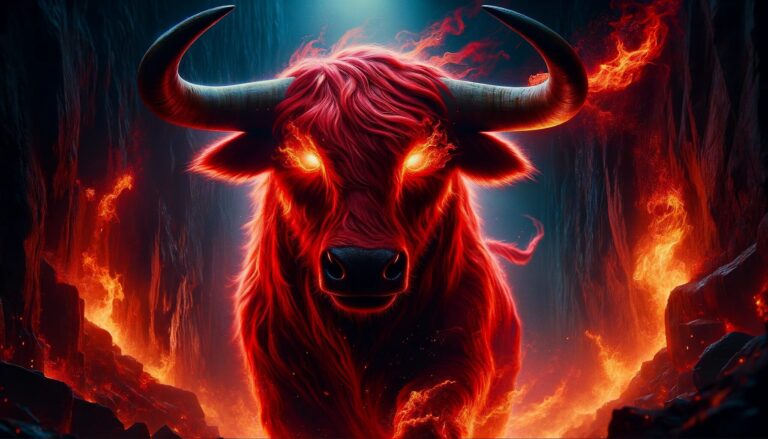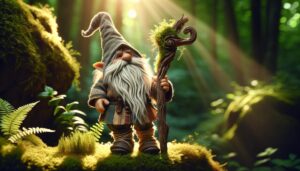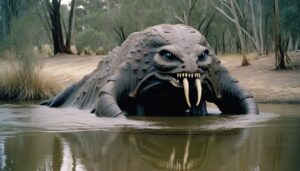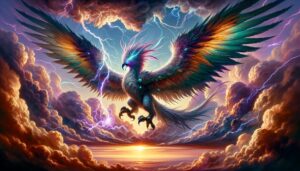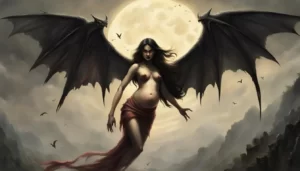Table of Contents
Aatxe, also known as “Aatxegorri” or “Aatxe Gorri,” is a mythical creature from Basque folklore. It is often described as a malevolent spirit or a supernatural being that takes the form of a red bull with fiery eyes and sharp horns. Aatxe is said to inhabit caves and caverns in the Pyrenees mountains, particularly in the Basque Country, a region that spans parts of northern Spain and southwestern France.
In Basque mythology, Aatxe is associated with danger and mischief, and it is believed to be responsible for causing harm to humans who venture into its territory or disrespect sacred places. Some legends also suggest that Aatxe can shape-shift into the form of a handsome young man to seduce and deceive people.
Aatxe is one of many fascinating creatures found in Basque folklore, which has a rich tradition of mythical beings and legends.
Origins
The origins of Aatxe are deeply rooted in Basque folklore and mythology, which has a long and unique history. The Basque Country is an ethnically and culturally distinct region located in the Pyrenees Mountains, spanning parts of northern Spain and southwestern France. Basque folklore is characterized by its rich oral traditions and distinctive mythological creatures like Aatxe.
Aatxe’s origins are believed to be ancient, predating recorded history, and passed down through generations via oral storytelling. The creature is closely tied to the natural landscape of the Basque Country, with its associations with caves and the rugged terrain of the Pyrenees mountains.
In Basque mythology, Aatxe is often considered a malevolent being, and its stories serve as cautionary tales, warning people of the dangers of venturing into unknown or sacred places. The image of a red bull with fiery eyes and sharp horns reflects the Basque reverence for the power and mystery of nature.
The exact origin story of Aatxe and the reasons behind its malevolent nature may vary from one Basque community to another, as folklore often evolves and adapts over time. Nonetheless, Aatxe remains a fascinating figure in Basque mythology and continues to be a symbol of the region’s unique cultural heritage.
Aatxe, in Basque folklore, is typically described as a supernatural creature with distinctive physical characteristics. While there may be some variations in its appearance in different legends and stories, the following is a common description of Aatxe:
Red Bull: Aatxe is often depicted as a large, red bull. Its fur or skin is said to be deep red in color, giving it a striking and menacing appearance.
Fiery Eyes: Aatxe is known for its eyes, which are said to glow with a fiery or fiery-red intensity. This fiery gaze is part of what makes the creature unsettling and intimidating.
Sharp Horns: The bull has sharp, pointed horns that add to its fearsome appearance. These horns are sometimes described as being made of iron.
Form-Shifting Abilities: In some versions of the Aatxe legend, the creature has the ability to shape-shift into the form of a handsome young man. This ability allows it to deceive and seduce people.
Personality
In Basque folklore, Aatxe is often portrayed as a malevolent and mischievous entity with a somewhat sinister personality. Its characteristics and behavior:
Malice: Aatxe is known for its malicious intent, and it is often associated with causing harm or danger to humans who encounter it. It is not a benevolent or friendly being.
Deception: In some versions of the Aatxe legend, the creature has the ability to shape-shift into a handsome young man. It uses this transformation to deceive and seduce people, leading them astray or luring them into dangerous situations.
Guardian of Sacred Places: Aatxe is sometimes considered a guardian of sacred caves and caverns in the Pyrenees mountains. It is believed to become particularly active when these sacred places are disrespected or when people venture into its territory without proper reverence.
Trickster: Aatxe is often viewed as a trickster figure, playing pranks on humans or leading them into perilous situations through cunning and deceit.
Aatxe’s personality traits are consistent with the idea of a supernatural being that poses a threat to those who encounter it, and it serves as a cautionary figure in Basque folklore, warning people of the potential dangers of the natural world and the consequences of disrespecting sacred places.
Special Abilities
In Basque folklore, Aatxe is a supernatural creature with certain special abilities and characteristics that make it a unique and mysterious entity. Some of its notable abilities and traits include:
Shape-Shifting: Aatxe is often attributed with the ability to shape-shift, particularly into the form of a handsome young man. This transformation allows it to deceive and seduce people, leading them astray or luring them into dangerous situations. This ability adds an element of trickery and cunning to Aatxe’s character.
Guardian of Caves: Aatxe is believed to inhabit caves and caverns in the Pyrenees mountains, particularly those that are considered sacred. It is sometimes seen as a guardian of these places, and its presence is said to become more active when people disrespect or desecrate these sacred sites.
Fiery Eyes: Aatxe is often described as having eyes that glow with a fiery or fiery-red intensity. This characteristic adds to its intimidating and otherworldly appearance, instilling fear in those who encounter it.
Malevolence: Aatxe is commonly associated with malevolent intent. It is often portrayed as a malevolent or mischievous entity that poses a threat to
humans, playing tricks on them or causing harm when crossed.
These special abilities and traits contribute to the enigmatic and cautionary nature of Aatxe in Basque folklore. It serves as a reminder of the mysterious and potentially dangerous aspects of the natural world and the consequences of disrespecting sacred places in the region.
In Modern Usage and Symbolism
In modern usage and symbolism, Aatxe may not be as widely recognized or referenced as some other mythical creatures, but it still holds significance in Basque culture and serves as a symbol of various concepts and ideas. Here are some ways in which Aatxe might be understood in contemporary contexts:
Cultural Identity: Aatxe is a unique figure in Basque folklore, and its continued presence in the cultural consciousness of the Basque people serves as a symbol of their distinct cultural identity. It represents a connection to ancient traditions and a reminder of the rich folklore that has been passed down through generations.
Environmental Awareness: Aatxe’s association with caves, mountains, and the natural world can be seen as a symbol of environmental awareness and conservation. In a modern context, Aatxe can remind us of the importance of respecting and preserving natural landscapes and sacred places.
Cautionary Tales: The stories of Aatxe and its malevolent behavior can be seen as cautionary tales in modern times. They emphasize the consequences of recklessness, disrespect, and deceit, serving as lessons for individuals and society as a whole.
Tradition and Heritage: Aatxe is a symbol of Basque folklore and tradition. In contemporary Basque culture, it may be used to celebrate and honor the region’s unique heritage, especially during cultural events, festivals, or in art and literature.
Myth and Imagination: Aatxe can also be appreciated as a symbol of the enduring power of myth and imagination. It represents the idea that myths and legends continue to shape our understanding of the world and inspire creativity.
Ralated and similar creatures
Many cultures around the world have their own mythical creatures or folklore entities that share similarities with Aatxe in terms of their characteristics or roles. Here are some examples of related or similar creatures from various cultures:
Minotaur (Greek Mythology): The Minotaur is a creature from Greek mythology that has the body of a man and the head of a bull. Like Aatxe, it is often associated with mazes and labyrinths and is considered a menacing figure.
Nian (Chinese Mythology): Nian is a legendary beast from Chinese folklore. It is said to come out on New Year’s Eve to terrorize villages, but it is scared away by loud noises, firecrackers, and the color red, which parallels some of Aatxe’s characteristics.
Chimera (Greek Mythology): The Chimera is a creature with the body of a lion, the head of a goat, and the tail of a serpent. It is known for its ferocity and is often associated with danger and destruction.
Kishi (African Folklore): In African folklore, the Kishi is a shape-shifting creature that can transform from a beautiful woman into a hyena. It lures men with its beauty and then reveals its true form, similar to Aatxe’s ability to shape-shift.
Púca (Irish Folklore): The Púca is a mischievous and shapeshifting creature in Irish folklore. It can take the form of various animals, including a black horse, a rabbit, or a bull, and it often plays tricks on humans.
Lamia (Various Mythologies): The Lamia is a creature found in various mythologies, including Greek and Middle Eastern folklore. It is often depicted as a female with a serpent’s lower body and can be associated with seduction and harm.
Krampus (Alpine Folklore): Krampus is a horned, anthropomorphic figure from Alpine folklore, often depicted as a demonic counterpart to Santa Claus. Krampus punishes naughty children during the Christmas season, similar to Aatxe’s malevolent nature.
These creatures share common themes of danger, deception, and supernatural abilities with Aatxe, even though they come from different cultural backgrounds. Myths and legends often reflect universal human fears and concerns, leading to the creation of similar creatures in various cultures around the world.
